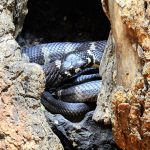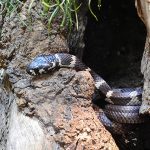STEPHENS' BANDED SNAKE
The Stephens’ Banded Snake: A Canopy Dweller of Eastern Australia
The Stephens’ banded snake is a remarkable reptile, uniquely adapted to life in the forests along Australia’s east coast. Endemic to this region, it represents an important part of the local ecosystem and provides a fascinating example of arboreal snake behaviour.
Distribution and Habitat
| Region | Description |
|---|---|
| Northernmost Range | Kroombit Tops, South-Eastern Queensland |
| Southernmost Range | Gosford Area, New South Wales |
| Altitudinal Distribution | Up to 950 metres above sea level |
| Preferred Microhabitat | High-rainfall remnant forests, canopy dwellers |
Within its range, the Stephens’ banded snake favours moist, mature forests with dense canopy cover. Recent studies reveal that it often resides around 20 metres high in the treetops, moving gracefully among branches where the filtered sunlight creates shifting patterns of light and shadow.
Sensory Experience
- Sight: If you peer up through the forest, you may spot a slender, banded figure draped across a sun-dappled branch, its colours blending with the interplay of bark and leaves.
- Sound: The forest canopy above is alive with the subtle rustling of leaves, occasionally punctuated by the soft movement of a snake gliding from one branch to another.
- Touch: The roughness of tree bark beneath its scales helps it anchor securely as it ascends or rests.
- Smell: The air here is rich with the earthy scent of rain-soaked wood and decomposing leaf litter, a testament to the healthy ecosystem these snakes inhabit.
Appearance and Identification
| Feature | Description |
|---|---|
| Average Adult Length | 50–70 cm |
| Body Shape | Slender, flexible |
| Colour Pattern | Distinct dark brown or black bands on the back |
| Head | Slightly broader than neck; pale yellow/orange |
The distinctive banding acts as camouflage among the dappled shadows of the canopy, while the pale head provides an arresting contrast, often the first feature noticed by careful observers.
Behaviour and Diet
- Activity: Primarily diurnal (active during the day)
- Diet: Prefers lizards, small mammals, and occasionally frogs
- Temperament: Generally shy, avoiding human presence when possible
- Defence: When threatened, may flatten its body and display defensive postures
Stephens’ banded snakes are agile climbers, relying on their slender build to navigate the high branches in search of prey. Their diet reflects the rich biodiversity of the forest, helping to maintain the balance of species within their habitat.
Safety and Conservation
Encountering Snakes
If you come across a Stephens’ banded snake—or any wild snake—observe from a safe distance. Their venom can be dangerous, and all bites require immediate medical attention. It is vital for your safety and the well-being of the snake to avoid handling or provoking it.
Conservation Insight
The reliance of Stephens’ banded snakes on intact forest canopies highlights the importance of preserving mature forests and their unique microhabitats. Conservation of these environments not only protects this species but also supports countless other organisms that share the treetops.
Key Takeaways
- The Stephens’ banded snake is a canopy specialist, endemic to the east coast of Australia.
- It is easily recognised by its slender, banded body and pale head.
- The species plays an important ecological role in controlling populations of small vertebrates.
- Respectful observation and forest conservation are essential for the ongoing survival of this unique reptile.
By learning about and respecting creatures such as the Stephens’ banded snake, we deepen our connection to the natural world and become advocates for its ongoing preservation.


